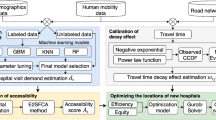Abstract
The research reported in this paper is part of a larger research effort to develop a methodology for estimating spatial interaction (migration) flows. The first section of the paper summarises the equivalences between the log-linear model and conventional spatial interaction models. It is shown under what conditions the values of the balancing factors of the gravity model coincide with the parameter values of the loglinear model. The second section focuses on theanalysis of (known) spatial interaction flows. The effects associated with the region of origin, region of destination and spatial separation are identified and quantified. A ‘distance effect’ is derived from the flow matrix. A measure of accessibility is developed and compared with accessibility measures derived from different forms of distance functions. The third section deals with theestimation of spatial interaction flows. It is shown how the quality of the estimates (and hence the model performance) can be improved by efficiently adding information. This is particularly relevant in the estimation of disaggregated spatial interaction flows.
Similar content being viewed by others
References
Batten, D. 1982. The location-production-interaction model revisited. Paper presented at the XXII European Congress of the Regional Science Association, Groningen.
Baxter, M. J. and Ewing, G. O. 1979. Calibration of production-constrained trip distribution models and the effect of intervening opportunities.Journal of Regional Science 19: 319–30.
Birch, M. 1963. Maximum likelihood in three-way tables.Journal of the Royal Statistical Society, Series B 25: 220–33.
Bishop, Y. M., Fienberg, S. E. and Holland, P. W. 1975.Discrete multivariate analysis: theory and practice. Cambridge, Massachusetts: M.I.T. Press.
Caussinus, H. 1965. Contribution a l'analyse statistique des tableaux de corrélation.Annales de la Faculté des Sciences de l'Université de Toulouse 29: 77–182.
Charnes, A., Haynes, K. A., Phillips, F. and White, G. 1977. Dual extended geometric programming problems and the gravity model.Journal of Regional Science 17: 71–76.
Charnes, A., Haynes, K. A. and Phillips F. 1976. A ‘generalized distance’ estimation procedure for intraurban interaction.Geographical Analysis 8: 289–94.
Charnes, A., Raike, W. and Bettinger, C. 1972. An extremal and information-theoretic characterization of some interzonal transfer models.Socio-Economic Planning 6: 531–37.
Darroch, J. N. and Ratcliff, O. 1972. Generalized iterative scaling for loglinear models.Annals of Mathematical Statistics 43: 1470–80.
Davis, J. A. 1978. Hierarchical models for significance tests in multivariate contingency tables: an exegesis of Goodman's recent papers. In L. Goodman,Analyzing qualitative/categorical data, ed. J. Magidson, pp. 233–75. Cambridge, Massachusetts: ABT Books.
Deming, W. and Stephan, F. 1940. On a least squares adjustment of a sampled frequency table when expected marginal totals are known.Annals of Mathematical Statistics 11: 427–44.
Dinkel, J., Kochenberger, G. and Wong, S. 1977. Entropy maximization and geometric programming,Environment and Planning 9: 419–27.
Evans, S. P. 1973. A relationship between the gravity model for trip distribution and the transportation problem in linear programming.Transportation Research 7: 39–61.
Goodman, L. A. 1968. The analysis of cross-classified data: independence, quasi-independence and interactions in contingency tables with or without missing entries.Journal of the American Statistical Association 324: 1091–131.
Haberman, S. J. 1979.Analysis of qualitative data 2 Vols. New York: Academic Press.
Hauser, R. M. 1979. Some exploratory methods for modelling mobility tables and other cross-classified data. InSociological Methodology 1980, ed. K. F. Schuessler, pp. 413–58. San Francisco: Jossey-Bass Publishers.
Hua, C. and Porell, F. 1979. A critical review of the development of the gravity model.International Regional Science Review 4: 97–126.
MacFadden, D. 1978. Modelling the choice of residential location. InSpatial interaction theory and planning models, eds. A. Karlqvist, L. Lundqvist, F. Snickars and J. Weibull, pp. 75–96. Amsterdam: North-Holland Publ. Co.
Macgill, S. M. 1975.Balancing factor methods in urban and regional analysis. Leeds: Department of Geography, University of Leeds, Working Paper 124.
Macgill, S. M. 1977. Theoretical properties of biproportional matrix adjustments.Environment and Planning A 9: 687–701.
March, L. 1971. Urban systems: a generalized distribution function. InUrban and regional planning (London Papers in Regional Science, Vol. 2), ed. A. G. Wilson. London: Pion Ltd.
Nijkamp, P. 1975. Reflections on gravity and entropy models.Regional Science and Urban Economics 5: 203–25.
Openshaw, S. 1979. Alternative methods of estimating spatial interaction models and their performance in short-term forecasting. InExploratory and explanatory statistical analysis of spatial data, eds. C. P. A. Bartels and R. H. Ketellapper, pp. 201–25. Boston: Martinus Nijhoff Publishing.
Payne, C. 1977. The log-linear model of contingency tables. InAnalysis of survey data. Vol. 2: model fitting, eds. C. O'Muircheartaigh and C. Payne, pp. 105–44. New York: Wiley.
Scholte, H. 1982. Prescribing and forecasting migration within a housing market area. The loglinear model used as a spatial interaction model.Geografische en Planologische Notities no. 20. Amsterdam: Institute for Geographical Studies and Urban and Regional Planning, Free University.
Sikdar, P. K. and Hutchinson, B. G. 1981. Empirical studies of work trip distribution models.Transportation Research Journal: A 15A, 3: 233–43.
Snickars, F. and Weibull, J. W. 1977. A minimum information principle. Theory and practice.Regional Science and Urban Economics 7: 137–68.
Whitney, J. B. and Boots, B. N. 1979. An examination of residential mobility through the use of log-linear model. Part II: empirical results.Regional Science and Urban Economics 9: 393–409.
Willekens, F. 1980. Entropy, multiproportional adjustment and analysis of contingency tables.Systemi Urbani 2: 171–201.
Willekens, F. 1982. Multidimensional population analysis with incomplete data. InMultidimensional mathematical demography, eds. K. Land and A. Rogers, pp. 43–111. New York: Academic Press.
Willekens, F. and Baydar, N. 1983. Hybrid log-linear models. Voorburg: NIDI Working Paper No. 41.
Willekens, F., Por, A. and Raquillet, R. 1979.Entropy, multiproportional and quadratic techniques for inferring detailed migration patterns from aggregate data. Mathematical theories, algorithms, applications and computer programs. Laxenburg, Austria: I.I.A.S.A., Working Paper WP-79-88.
Willekens, F. and Tan, E. 1980. Entropy maximization, geometric programming and biproportional adjustment. Unpublished research note. Available from author.
Wilson, A. G. 1970.Entropy in urban and regional modelling. London: Pion Ltd.
Author information
Authors and Affiliations
Rights and permissions
About this article
Cite this article
Willekens, F. Log-linear modelling of spatial interaction. Papers of the Regional Science Association 52, 187–205 (1983). https://doi.org/10.1007/BF01944102
Issue Date:
DOI: https://doi.org/10.1007/BF01944102




